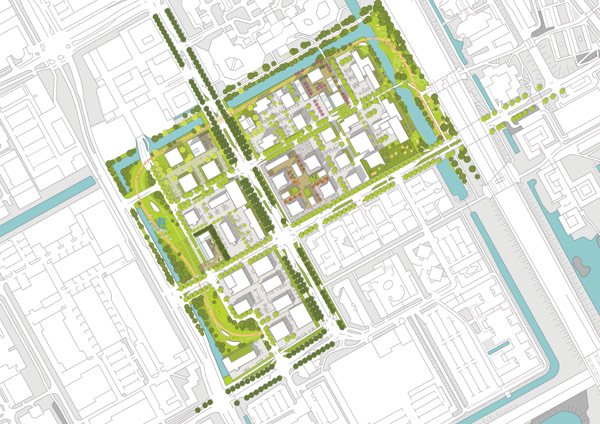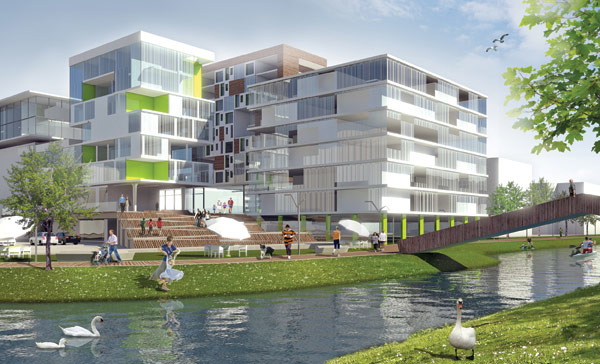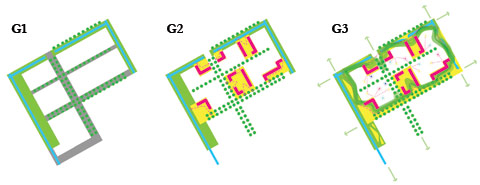Druga nagrada – tim “BASIC CITY”
Autori: Matteo Bettoni, Yong Cui, Bart Pouw, Sarah Wolff, Milena Zaklanović, Petar Zaklanović
Plan otkriva i predlaže način za eksploataciju latentnog prostornog kvaliteta monofunkcionalne poslovne zone Amstel III u Amsterdamu u cilju njene postepene regeneracije. Kao takav predloženi koncept teži alternativnom, ali ipak izvodljivom modelu razvoja sličnih oblasti u Holandiji, ali i drugde, koji usaglašava ambicije i interese svih relevatnih učesnika u razvoju grada danas.
Nakon poslednjih par dekada ekonomskog razvoja koji je između ostalog rezultovao i porastom u izgradnji broja kuća i poslovnih zgrada, recesija koja je započela početkom 21-og veka dovela je do naglih promena na tržištu nekretnina u Holandiji i ostatku Evrope. Izgradnja stambenih jedinica je naglo opala, a veliki deo poslovnog prostora je ostao prazan. Ovo poslednje nije isključivo posledica svetske ekonomske krize, već i promena u načinu na koje se savremeno poslovanje obavlja. Sve se veći deo posla obavlja preko interneta i gubi se potreba za fizičkim prostorom u meri u kojoj je to ranije bilo neophodno. Kao rezultat toga, Amsterdam danas ima 1,3 miliona kvadratnih metara slobodnog poslovnog prostora od koga se veliki deo smatra strukturalno praznim. Termin «strukturalna praznina/neokupiranost» uveden je kako bi objasnio očiglednu nepovratnost u predhodno stanje, a primenjuje se ukoliko je zgrada kontinuirano neokupirana 3 godine za redom.
Područje Amstel III je velika poslovna zona na jugoistoku Amsterdama, veličine 16 hektara, na strateški dobrom mestu, sa dobrom infrastrukturom i saobraćajnom vezom sa ostalim delovima grada. Jedan od najvećih problema ovog područja je loš kvalitet otvorenih prostora, kako privatnih, tako i javnih. Nema dovoljno prostora za pešake i bicikliste, nedostaju mesta na kojima bi zaposleni mogli da se odmore i provedu pauzu. Prevelika je dominacija automobila. Takođe nedostaju sadržaji koji bi doveli do povećanja aktivnosti tokom dana. Ova dva problema zajedno oslikavaju oblast bez ikakvog identiteta.
Zemljište je u vlasništvu opštine, ali su zgrade iznajmljene na duge rokove različitim vlasnicima, te je stoga interes fragmentiran i nema zajedničkog tela koje bi imalo u interesu ulaganje u razvoj ove oblasti na duži vremenski period. Grad sa druge strane, kao vlasnik zemljišta, ima veliki interes za unapređenje ove oblasti, ali nema dovoljno sredstava za ulaganje, niti jasnu viziju.
U takvim okolnostima, Amstel III se tretira kao “obećavajuće problematično područje”. Jednom rečju, prostor koji poseduje određene kvalitete, ali čija eksploatacija predstavlja dosta kompleksan zadatak – pronalaženje strategije za razvoj koja može da pomiri sve interese i ujedini sve aktere u zajedničkom zadatku tranformacije ove oblasti.
Težište našeg predloga je bila matrica ključnih strategija planiranja. Ta matrica uzajamno povezuje oblasti infrastrukture i urbanizma sa 3 različita nivoa intervencije: grad, susedstvo i blok/arhitektura.
Postojeći prostorni okvir na nivou grada povezuje područje Amstel III kako sa istorijskim centrom, tako i sa postojećim zelenim površinama na periferiji.
Javni prostor je artikulisan kroz unapređenje prostora oko postojećeg urbanog rastera. On povezuje nekoliko manjih projekata, anticipiranih na mestima gde nivo neiskorišćenosti izgrađenog prostora implicira neophodnost intervencije.
Rezultat je transformacija kvarta u eksperimentalno, hibridno naselje, u kome se postojeći poslovni program meša sa stambenim, komercijalnim, rekreativnim i kulturnim. Kao takvo, novo naselje sa sopstvenim identitetom postaje još jedno u nizu raznovrsnih prostornih oblasti po kojima je Amsterdam poznat.
Ključni parametri za definisanje karaktera transformacije
Mogućnosti koje pruža prostorni kontekst – Ključni potencijal svakog prostornog razvoja predstavlja sam kontekst. Specifični javni prostorni ambijenati u osnovi definišu projekte planirane na lokaciji.
Prazni postojeći poslovni objekti – Postojeći poslovni objekti sa 80% strukturalne neokupiranosti teže transformaciji u stambene prostore. Postojeće zgrade sa strukturalnom neokupiranošću između 80% i 30% pre će se koristiti kao prateći objekti naselja. Prazne površine potrebno je koncentrisati u prizemlju poslovnih objekata i tako omogućiti da novi sadržaji aktiviraju okolni javni prostor.
Pokrivenost postojećih parcela – Postavljanje novih objekata na postojećoj parceli je više izvesno ukoliko je pokrivenost parcele 25% ili manje.
Zelena tampon zona i rekreativna zona naselja – Pored formiranja potrebne izolacije od kapacitetnog saobraćajnog koridora i ostalih područja lokacije akcenat je na prostorima za rekreaciju i odmor sa paviljonima koji dalje aktiviraju zonu. Minimalna investicija, posebno u trenutnom nepogodnom finansijskom kontekstu, formira izvorni katalizator naselja, dok se generalno lokacija čuva za bolje finansijske situacije.
Prilaz naselju – Savršeno mesto za postavljanje simbola transformacije, komunikator ostvarenog uspeha.
Bulevar, stanica metroa i trg stanice – Svaki razvoj u okviru područja treba da podstakne artikulaciju ambijenta jednog urbanog bulevara sa jasno razrađenim prostorom oko stanice metroa.
Zeleno i vodeno okruženje – Postoji mogućnost za iskorišćavanjem postojećeg kvaliteta uz skromna ulaganja. Okolni razvoj treba da profitira okretanjem ka javnim prostorima dobrog kvaliteta.
G1. prepoznavanje i naglašavanje postojeće urbane matrice
Prepoznavanje i korišćenje postojećih kvaliteta – Pored očigledne funkcionalne uloge urbano rasterizovano okruženje i presecanje lokacije takođe imaju latentni prostorni kvalitet. Otkrivanje i upotreba ovog potencijala ključni su za transformaciju područja.
G2. postavljanje ključnih projekata koji dovode do programske raznolikosti i revitalizacije javnog prostora
Ključni projekti = diverzitet sadržaja i revitalizacija oblasti – Prilikom transformacije funkcije oblasti postoji finansijska opcija da se, umesto plaćanja zemljišta, novac investira u kvalitet javnog prostora oko projektom obuhvaćene zone. Planirani projekti, pored toga što uvode programski diverzitet, takođe doprinose poboljšanju kvaliteta javnih prostora oko njih. Oni postaju polazne tačke generalnog poboljšanja javnog prostora.
G3. artikulacija novog susedstva započinje proces dalje regeneracije
Artikulacija novog naselja započinje proces dalje regeneracije – Povezivanjem javnog prostora duž urbanog rastera i poboljšanog javnog prostora oko predloženog projekta u jednu celinu ostvaren je novi tip naselja. Integrisano u širi kontekst putem upotrebe jednostavne urbane matrice, naselje postaje polazište za celokupan proces transformacije područja. U isto vreme novi planirani sadržaji iniciraju reupotrebu ostalih praznih prostora na lokaciji i dalje regenerisanje područja.
Second prize – team “BASIC CITY”
Authors: Matteo Bettoni, Yong Cui, Bart Pouw, Sarah Wolff, Milena Zaklanović, Petar Zaklanović
The plan reveals and proposes a way to exploit the latent spatial quality of the unifunctional area Amstel III in Amsterdam in order to activate its gradual regeneration. As such, the proposed concept seeks alternative but feasible model of the development of similar areas in the Netherlands and elsewhere, which harmonizes the ambitions and interests of all relevant participants in the development of the city today.
During the several decades economic development had led to the increase in the building activity, construction of houses and office buildings. Recession that began in the early 21th century induced the change in the real estate market in Holland and the rest of Europe. The building of the housing units has declined rapidly and much of office spaces have remained empty. That happened not just because of the global economic crisis, but also because of the changes in modern business operations. More and more business is conducted over the internet and the need for physical space is decreasing. As a result, Amsterdam now has 1.3 million square feet of free office space and most of it is considered structurally empty. The term “structural gap/inoccupation” was introduced to explain the apparent irreversibility to the previous state, and it is applied in case the building is continuously unoccupied 3 years in a row.
Area Amstel III is a 16 hectares business zone in the southeast of Amsterdam, strategically well placed, with good infrastructure and transport links with other parts of the city. One of the biggest problems of this area is the poor quality of open spaces, both private and public. There is not enough space for pedestrians and cyclists, the spaces for relaxation and brake from work are missing. There is an overall-dominance of the vehicles. Also, the contents that could increase zone activities during the day are missing. These two problems together portray an area without any identity.
The land is owned by the municipality, but the buildings are leased on long-term contracts to different owners, and therefore the interest is divided and there is no common body that would be interested in investing in the development of this area in the long run. The city, on the other hand, as a landowner, has a great interest in improving this area, but there are not enough funds for the investment, and no clear vision.
In such circumstances, Amstel III area is treated as a “promising problem area”. In a word, a space that has certain qualities, but which exploitation is quite a complex task, that is creating a development strategy which could reconcile and unite all the interests of all stakeholders in the common task of transforming of the area.
The matrix of key strategies is in the heart of our proposal. It interlinks realms of infrastructure and urban condition with the three different scales of interventions: city, neighborhood and architecture. Existing spatial framework on the city scale, links the site to both the old city and the green areas at the periphery. Public space is articulated through the improvement of the existing urban grid. New hybrid city quarter is triggered by several small-scale key urban regeneration projects and added to the Amsterdam’s rich collection of distinct urban neighborhoods. Transformed vacant office space is mixed with voluminous new residential typologies, enriched by private and communal outdoor space. Proposed plan discovers the latent qualities of AMSTEL_3 and similar areas Europe wide. Change in the perception of those qualities leads to a truly alternative, yet realizable development model that respects the current state of mind of the key players in the urban development.
Key parameters for defining the character of transformation
Opportunities from the spatial context – Key opportunities for any spatial development lie in the spatial context itself. A number of distinct public space ambients crucially determine the envisioned projects on the site.
Vacancy of the existing office buildings – Existing office buildings with more than 80% structural vacancy are much more likely to transform into the residential use. Existing office buildings with the structural vacancy between 80% and 30% are likely to transform into the neighbourhood facilities. The vacant surface should be condensed to the ground floor of the office buildings, enabling the new program to activate the public space around.
Coverage of the existing plots – Adding new buildings onto an existing plot is much more possible if the coverage of the plot is 25% and less.
Green buffer and neighbourhood recreation zone – While creating a sufficient buffer between a strong infrastructure corridor and the rest of the site, the accent is on recreational and leisure uses with some temporary pavilions further activating the space. The minimum investment, especially in the current the hostile financial context, creates the ultimate neighbourhood catalyst, while saving the land for better investment time.
Entrance to the neighbourhood – Perfect spot to envision the symbol of the transformation, communicator of the achieved success.
Station boulevard and Station plaza – Any development in the area should help articulate the ambient of an urban boulevard, with a distinctly elaborated space around the metro station.
Green and water landscape area – There is an opportunity for the consolidation of the existing quality via modest financial means. The development around should profit by opening to the good quality public space.
G1. recognizing and highlighting the existing urban matrix
Recognition and utilization of the existing qualities – Beside it’s obvious functional role, the urban grid surrounding and cutting through the site also holds a latent spatial quality. Revealing and utilizing that potential is the key for the transformation of the area.
G2. setting of key projects that lead to program diversity and revitalization of public space
Key projects = program diversity and revitalization the public realm – When transforming a site into another use, there is a financial possibility to, instead of paying for the land, invest the money into the quality of the public space around the project. Therefore, the envisioned projects, besides bringing the programmatic diversity, also contribute to the improvement of the public space quality around them. They become the hotspots in the line of the over all improvement of the public space.
G3. articulation of the new neighborhood activates the process of further regeneration
Articulation of the new neighbourhood sparkles further regeneration – Connecting two, public space along the urban grid and improved public space around the proposed projects into one coherent whole, a new kind of neighbourhood is established. Integrated into the wider context via the simple urban grid, the neighbourhood becomes the seed for the overall transformation of the area. At the same time the new program sparkles the reuse of the rest of the vacant space on the site and further regenerates the area.












